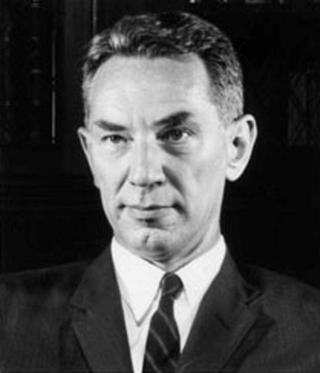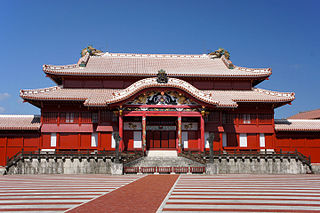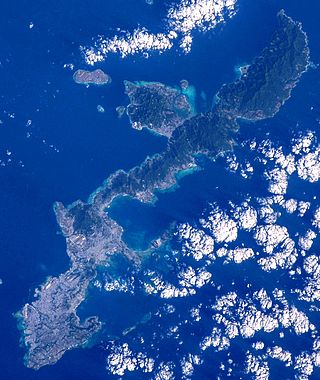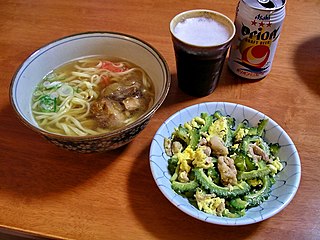
The Battle of Okinawa, codenamed Operation Iceberg, was a major battle of the Pacific War fought on the island of Okinawa by United States Army and United States Marine Corps forces against the Imperial Japanese Army. The initial invasion of Okinawa on 1 April 1945 was the largest amphibious assault in the Pacific Theater of World War II. The Kerama Islands surrounding Okinawa were preemptively captured on 26 March by the 77th Infantry Division. The 82-day battle on Okinawa itself lasted from 1 April until 22 June 1945. After a long campaign of island hopping, the Allies were planning to use Kadena Air Base on the island as a staging point for Operation Downfall, the planned invasion of the Japanese home islands, 340 mi (550 km) away.

Okinawa Prefecture is the southernmost and westernmost prefecture of Japan. It has a population of 1,457,162 and a geographic area of 2,281 km2.

The Ryukyuans are a Japonic-speaking East Asian ethnic group indigenous to the Ryukyu Islands, which stretch from the island of Kyushu to the island of Taiwan. Administratively, most Ryukyuans live in either Okinawa Prefecture or Kagoshima Prefecture within Japan. They speak the Ryukyuan languages, considered to be one of the two branches of the Japonic language family, the other being Japanese and its dialects.

Edwin Oldfather Reischauer was an American diplomat, educator, and professor at Harvard University. Born in Tokyo to American educational missionaries, he became a leading scholar of the history and culture of Japan and East Asia. Together with George M. McCune, a scholar of Korea, in 1939 he developed the McCune–Reischauer romanization of the Korean language.

This article is about the history of the Ryukyu Islands, located southwest of the main islands of Japan.

The Ryukyu Kingdom was a kingdom in the Ryukyu Islands from 1429 to 1879. It was ruled as a tributary state of imperial Ming China by the Ryukyuan monarchy, who unified Okinawa Island to end the Sanzan period, and extended the kingdom to the Amami Islands and Sakishima Islands. The Ryukyu Kingdom played a central role in the maritime trade networks of medieval East Asia and Southeast Asia despite its small size. The Ryukyu Kingdom became a vassal state of the Satsuma Domain of Japan after the invasion of Ryukyu in 1609 but retained de jure independence until it was transformed into the Ryukyu Domain by the Empire of Japan in 1872. The Ryukyu Kingdom was formally annexed and dissolved by Japan in 1879 to form Okinawa Prefecture, and the Ryukyuan monarchy was integrated into the new Japanese nobility.

Masahide Ōta was a Japanese academic and politician who served as the governor of Okinawa Prefecture from 1990 until 1998. After starting his career as a professor at the University of the Ryūkyūs, he wrote books in English and Japanese, mostly about the Battle of Okinawa and Japan–United States bilateral relations following World War II. After his retirement as professor he was elected as governor and was best known for his strong stand against occupation of prefectural lands by military bases of United States, going against the Japanese central government at the time.

Okinawa Island, officially Okinawa Main Island, is the largest of the Okinawa Islands and the Ryukyu (Nansei) Islands of Japan in the Kyushu region. It is the smallest and least populated of the five main islands of Japan. The island is approximately 106 kilometres (66 mi) long, an average 11 kilometres (7 mi) wide, and has an area of 1,206.98 square kilometers (466.02 sq mi). It is roughly 640 kilometres south of the main island of Kyushu and the rest of Japan. It is 500 km northeast of Taiwan. The total population of Okinawa Island is 1,384,762. The greater Naha area has roughly 800,000 residents, while the city itself has about 320,000 people. Naha is the seat of Okinawa Prefecture on the southwestern part of Okinawa Island. Okinawa has a humid subtropical climate.

The United States Civil Administration of the Ryukyu Islands abbr. USCAR was the civil administration government in the Ryukyu Islands, Japan, replacing the United States Military Government of the Ryukyu Islands in 1950, and functioned until the islands were returned to Japan in 1972. It oversaw the native Ryukyuan Government. It could overrule all the decisions made by the native government.

Okinawan cuisine is the cuisine of the Okinawa Prefecture of Japan. The cuisine is also known as Ryūkyūan cuisine, a reference to the Ryukyu Kingdom. Due to differences in culture, historical contact between other regions, climate, vegetables and other ingredients, Okinawan cuisine differs from mainland Japanese cuisine.

Naha is the capital city of Okinawa Prefecture, the southernmost prefecture of Japan. As of 1 June 2019, the city has an estimated population of 317,405 and a population density of 7,939 people per km2. The total area is 39.98 km2 (15.44 sq mi).
The Ryukyu independence movement is a separatist movement in Japan advocating the independence of the Ryukyu Islands. Some support the restoration of the Ryukyu Kingdom, while others advocate the establishment of a Republic of the Ryukyus.

The Ryukyu Islands, also known as the Nansei Islands or the Ryukyu Arc, are a chain of Japanese islands that stretch southwest from Kyushu to Taiwan: the Ryukyu Islands are divided into the Satsunan Islands and Okinawa Prefecture. The larger ones are mostly volcanic islands and the smaller mostly coral. The largest is Okinawa Island.
Shō Hashi was a king of Chūzan, one of three tributary states to China on the western Pacific island of Okinawa. He is traditionally described as the unifier of Okinawa and the founder of the Ryukyu Kingdom. He was the son of the lord Shishō of the First Shō dynasty. Modern scholarship has connected Shishō's potential father, Samekawa, to a family of Southern Court-affiliated seafarers from the island of Kyushu, where Hashi was possibly born. Hashi became the lord of Sashiki Castle in southern Okinawa in 1392, becoming a noted military leader. In 1407, following a diplomatic incident between the Chūzan king Bunei and the Ming dynasty court, Shishō took the throne, attributed by the Ryukyuan official histories to a coup d'état by Hashi to install his father as king.
Tatsuhiro Ōshiro was an Okinawan novelist and playwright from Okinawa, Ryukyu Islands.
Shun Medoruma is a Japanese writer, who, along with Tatsuhiro Oshiro, Tami Sakiyama, and Eiki Matayoshi, is one of the most important contemporary writers from Okinawa, Japan. Early in his career he won the 11th Ryukyu Shimpō Short Story Prize in 1983 for "Taiwan Woman: Record of a Fish Shoal" ("Gyogunki"), translated by Shi-Lin Loh in Islands of Protest: Japanese Literature from Okinawa, and the New Okinawan Literature Prize in 1986 for "Walking the Street Named Peace Boulevard". He was awarded the 27th Kyushu Arts Festival Literary Prize and the 117th Akutagawa Prize in 1997 for his short story "A Drop of Water" ("Suiteki"). In 2000, his short story "Mabuigumi" won the prestigious Kawabata Yasunari and Kiyama Shōhei literary prizes. Medoruma also wrote the screenplay for the film Fūon: The Crying Wind, which received the Montreal Film Festival Innovation Prize in 2004, and published a novel based on the screenplay the same year. His critically acclaimed novel In the Woods of Memory is the first full-length novel by an Okinawan writer to be translated and published in English.

Albert Watson II was a United States Army lieutenant general. He participated in World War II and fought in a number of significant battles in the Pacific Theater, including the Battle of Okinawa. From May 1961 to January 1963, Watson served as Commandant of Berlin and commanded American military forces there when construction of the Berlin Wall began. A major diplomatic incident occurred when members of Watson's staff were refused access to East Berlin. Riots also broke out during his tenure following the death of Peter Fechter. From 1964 to 1965, Watson filled the position of Commissioner of the United States Civil Administration of the Ryukyu Islands. He increased Ryuku autonomy but ultimately spoke against the significant lessening of American administration authority in the Ryukyus. Watson received two Army Distinguished Service Medals during his career.

The United States Military Government of the Ryukyu Islands abbr. USMGR, also referred to as U.S. Ryukyu Islands, was the government in the Ryukyu Islands, Japan from 1945 to 1950, whereupon it was replaced by the United States Civil Administration of the Ryukyu Islands (USCAR).
A number of attempts have been made to create a flag of Ryukyu or Ryukyuan flag to represent the Ryukyuan people, the Ryukyu Islands, or the former Ryukyu Kingdom.
















